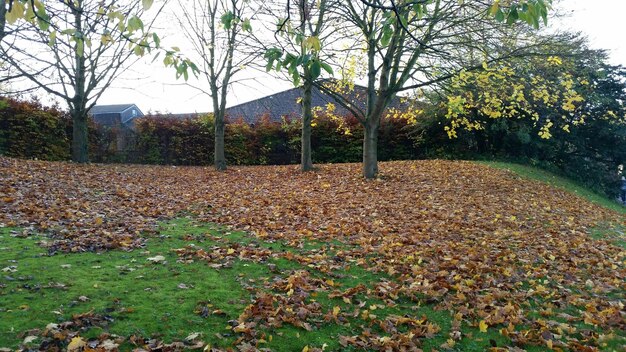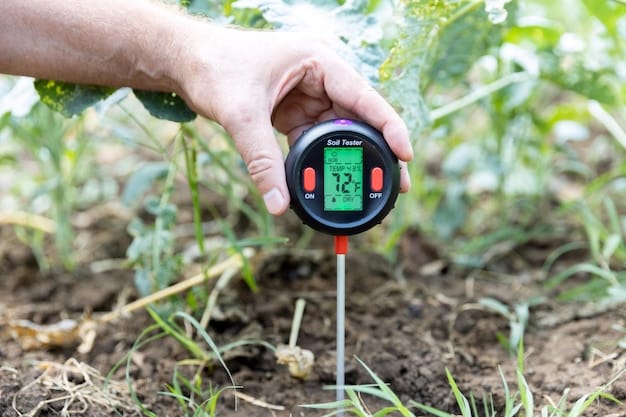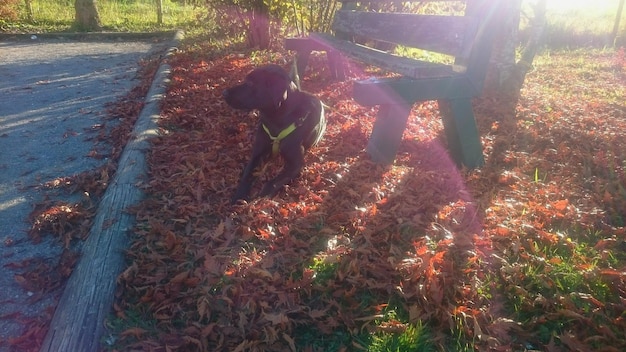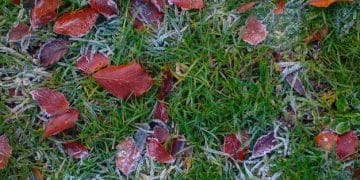Winterize Your Garden: Protect Your Plants from Freezing Temperatures

Winterizing your garden is essential to protect plants from freezing temperatures, involving tasks such as mulching, wrapping, and moving sensitive plants indoors to ensure their survival through the harsh winter months.
As the days grow shorter and the nights colder, it’s time to think about preparing your garden for winter. Learning how to winterize your garden: protect your plants from freezing temperatures is crucial for ensuring the survival and health of your beloved plants.
why Winterize Your Garden
Winterizing your garden is a proactive measure that protects your plants, enriches the soil, and sets the stage for a thriving spring garden. Understanding the importance of these efforts is key for both novice and experienced gardeners.
Let’s explore the main benefits of winterizing, setting the ground for a garden that is resilient and ready to flourish once the cold season passes.
Protecting Plants from Frost Damage
One of the primary reasons to winterize your garden is to shield your plants from frost damage. Cold temperatures and icy conditions can wreak havoc on plant tissues, leading to stunted growth or even death.
Protective measures like mulching and using frost blankets can maintain a more stable soil temperature and prevent the freeze-thaw cycles that damage roots.
Preventing Soil Erosion
Bare soil is susceptible to erosion from wind and rain during the winter months. This can strip away valuable topsoil and nutrients, depleting the soil quality for the following growing season.
Covering your garden with a layer of organic mulch or cover crops helps to anchor the soil, reducing erosion and preserving its fertility.
Enhancing Soil Health
Winterizing isn’t just about protecting plants; it’s also about improving soil health. Adding organic matter like compost or aged manure enriches the soil with essential nutrients and improves its structure.
As these materials decompose over the winter, they release nutrients that will be readily available to your plants in the spring.
Reducing Weed Growth
Winterizing can also help to suppress weed growth. A thick layer of mulch blocks sunlight, preventing weed seeds from germinating. This reduces the amount of weeding you’ll need to do in the spring, saving you time and effort.
- Mulch smothers weed seeds by preventing sunlight from reaching them.
- Cover crops outcompete weeds for resources like nutrients and water.
- Regularly removing any weeds that do emerge prevents them from spreading seeds.
In conclusion, winterizing your garden is essential for plant protection, soil health, and weed control. Taking the time to prepare your garden for winter ensures it will thrive in the spring with minimal effort.
assessing Your Garden’s Needs
Before diving into winterizing tasks, take a thorough assessment of your garden’s needs. This involves understanding your local climate, evaluating existing plants, and identifying areas that require special attention.
Assessing your garden’s unique requirements will help you tailor your winterizing strategy for optimal results.
Knowing Your Climate Zone
Understanding your climate zone is crucial for determining the specific winterizing measures your garden requires. Different regions experience varying levels of cold, snowfall, and frost, which all impact plant survival.
Refer to the USDA Plant Hardiness Zone Map to identify your zone, and then research the hardiness of your plants to ensure they can withstand local winter conditions.

Evaluating Existing Plants
Assess the health and hardiness of your existing plants. Identify those that are susceptible to frost damage or require special protection.
Evergreens, perennials, and young trees are particularly vulnerable and may need extra care. Note any signs of disease or pest infestation, as these can weaken plants and make them more susceptible to winter damage.
Identifying Areas of Concern
Walk through your garden and identify areas that require special attention. This may include low-lying spots prone to waterlogging, exposed areas susceptible to windburn, or plants located in containers that need to be moved indoors.
Addressing these specific concerns will help prevent potential problems and ensure your plants make it through the winter in good health.
Soil Testing
Conducting a soil test prior to winterizing can provide valuable insights into nutrient deficiencies and pH imbalances. This allows you to amend the soil with appropriate organic matter or soil conditioners to improve its fertility and structure.
- Collect soil samples from various areas of your garden.
- Send the samples to a local soil testing lab for analysis.
- Amend the soil based on the lab’s recommendations to correct any deficiencies.
In conclusion, assessing your garden’s needs is a critical first step in the winterizing process. Knowing your climate zone, evaluating existing plants, identifying areas of concern, and testing your soil will enable you to create a tailored winterizing strategy that meets your garden’s specific requirements.
gathering Essential Supplies
Before winter arrives, gather all the essential supplies you’ll need for winterizing your garden. Having these items on hand will make the process more efficient and ensure you’re well-prepared to protect your plants.
From mulches to plant covers, these essential supplies will safeguard your garden against the harsh winter elements.
Mulch
Mulch is a fundamental winterizing supply that provides insulation, protects roots, and conserves moisture. Organic mulches like straw, shredded leaves, wood chips, or pine needles are excellent choices.
Apply a thick layer of mulch around the base of plants to maintain a more stable soil temperature and prevent freeze-thaw cycles.
Plant Covers
Plant covers, such as frost blankets or burlap, offer an extra layer of protection against frost, wind, and snow. These covers create a barrier that traps heat and shields plants from harsh winter conditions.
Use plant covers to protect vulnerable plants like tender perennials, evergreens, or newly planted shrubs.
Tree Wraps
Tree wraps are designed to protect the trunks of young trees from sunscald, rodent damage, and temperature fluctuations. These wraps are typically made of paper or plastic and are wrapped spirally around the trunk.
Apply tree wraps in the fall and remove them in the spring to prevent moisture buildup and potential fungal growth.
Gardening Tools
Make sure you have all the necessary gardening tools for winterizing, including gloves, shovels, rakes, and pruning shears. Clean and sharpen your tools before winter to ensure they’re ready for use in the spring.
Properly maintained tools will make winterizing tasks easier and more efficient.
Soil Amendments
If your soil test revealed nutrient deficiencies or pH imbalances, gather the appropriate soil amendments, such as compost, aged manure, or lime. Adding these amendments in the fall allows them to decompose over the winter, improving soil fertility for the spring.
- Compost: Enriches soil with organic matter and nutrients.
- Aged manure: Provides slow-release nutrients and improves soil structure.
- Lime: Raises soil pH and makes nutrients more available to plants.
In conclusion, gathering essential supplies is a crucial step in preparing your garden for winter. Having mulch, plant covers, tree wraps, gardening tools, and soil amendments on hand will ensure you’re well-equipped to protect your plants and improve soil health.
mulching for Winter Protection
Mulching is a critical practice for winterizing your garden, providing insulation, conserving moisture, and suppressing weeds. Choosing the right mulch and applying it correctly are key to maximizing its benefits.
By understanding the best mulching techniques, you can safeguard your plants and set the stage for a thriving garden come springtime.
Choosing the Right Mulch
Select a mulch that suits your plants’ needs and your local climate. Organic mulches like straw, shredded leaves, wood chips, and pine needles are all excellent choices, each offering unique advantages.
Consider the texture, decomposition rate, and nutrient content of each mulch to determine the best option for your garden.
Applying Mulch Correctly
Apply a thick layer of mulch around the base of plants, typically 2-4 inches deep. Be sure to keep the mulch away from the plant stems to prevent rot. Extend the mulch layer out beyond the plant’s drip line to protect the entire root zone.
Avoid piling mulch directly against tree trunks, as this can create a moist environment that attracts pests and diseases.
Mulching Tender Perennials
Tender perennials that are not fully hardy in your climate zone benefit from a thick layer of mulch for added insulation. Apply a generous layer of straw or shredded leaves around the base of these plants to protect them from freezing temperatures.
For extra protection, consider using a combination of mulch and plant covers to create a warm, insulated microclimate around the plants.

Mulching Vegetable Gardens
In vegetable gardens, mulching helps retain soil moisture, suppress weeds, and protect the soil from erosion. Apply a layer of straw or shredded leaves to bare soil after removing spent plants.
Consider planting a cover crop like annual rye or winter wheat in areas where vegetables will not be grown over the winter. Cover crops help prevent soil erosion and improve soil fertility.
Benefits of Different Mulch Types:
- Straw: Provides excellent insulation and is ideal for protecting tender perennials.
- Shredded Leaves: Decomposes slowly, adding nutrients to the soil over time.
- Wood Chips: Suppresses weeds effectively and is long-lasting.
- Pine Needles: Acidifies the soil and is suitable for acid-loving plants.
In conclusion, mulching is an essential winterizing practice that protects plants, conserves moisture, and suppresses weeds. By choosing the right mulch and applying it correctly, you can ensure your garden remains healthy and productive throughout the winter months.
protecting Tender Plants
Protecting tender plants is crucial for ensuring their survival during the winter months. These plants are more susceptible to frost damage and require extra care to withstand the cold temperatures.
By understanding the specific needs of tender plants and implementing appropriate protective measures, you can keep them healthy and thriving.
Moving Plants Indoors
One of the most effective ways to protect tender plants is to move them indoors. Container plants and potted herbs can be easily relocated to a sheltered location, such as a garage, basement, or greenhouse.
Before bringing plants indoors, inspect them for pests or diseases to prevent infestations from spreading to other houseplants.
Using Plant Covers
Plant covers, such as frost blankets or burlap, provide an extra layer of protection against frost and wind. These covers trap heat and create a warmer microclimate around the plants.
Drape plant covers over vulnerable plants, making sure they extend to the ground to trap heat. Secure the covers with stakes or weights to prevent them from blowing away.
Wrapping Plants
Wrapping plants with burlap or horticultural fleece is another effective way to protect them from cold temperatures. Wrap the foliage and stems of tender shrubs and trees with multiple layers of material to provide insulation.
Secure the wrapping with twine or plant tape to keep it in place throughout the winter.
Watering and Fertilizing
Reduce watering during the winter months, as plants require less moisture when they are dormant. Water only when the soil feels dry to the touch.
Avoid fertilizing plants in the winter, as this can stimulate new growth that is vulnerable to frost damage. Resume fertilizing in the spring when plants begin to actively grow.
Tips for Protecting Specific Plants
- Roses: Prune back canes to 12-18 inches and mulch heavily around the base.
- Hydrangeas: Wrap the flower buds with burlap to protect them from frost.
- Fig Trees: Wrap the entire tree with burlap or horticultural fleece.
In conclusion, protecting tender plants requires careful planning and proactive measures. Moving plants indoors, using plant covers, wrapping plants, and adjusting watering and fertilizing practices are all essential steps in ensuring their survival during the winter months.
watering and Winter Irrigation
While it may seem counterintuitive, watering and winter irrigation are essential aspects of winterizing your garden. Proper hydration helps plants withstand the harsh winter conditions and prevents desiccation.
Understanding when and how to water during the winter is key to maintaining plant health and ensuring a vibrant spring garden.
Watering Before the Ground Freezes
Before the ground freezes solid, give your plants a deep watering. This helps hydrate the roots and provides them with a reserve of moisture to draw upon during the winter months.
Water thoroughly, allowing the moisture to penetrate deep into the soil. This is especially important for evergreens, which continue to transpire water throughout the winter.
Watering During Thaws
During periods of thaws, when the ground thaws partially, take the opportunity to water your plants, especially evergreens and newly planted trees. This helps replenish moisture lost through transpiration and prevents desiccation.
Water in the morning to allow the foliage to dry before nightfall, reducing the risk of fungal diseases.
Preventing Desiccation
Desiccation, or drying out, is a common problem for plants during the winter, especially evergreens exposed to wind and sun. To prevent desiccation, consider using anti-desiccant sprays or providing windbreaks.
Anti-desiccant sprays create a waxy coating on plant leaves, reducing water loss. Windbreaks, such as burlap screens or evergreen branches, shield plants from drying winds.
Avoiding Overwatering
While watering is important, avoid overwatering during the winter months. Overwatering can lead to root rot and other fungal diseases. Water only when the soil feels dry to the touch.
Ensure that your soil has good drainage to prevent water from pooling around the roots.
Tips for Watering in Winter
- Water early in the day to allow foliage to dry before nightfall.
- Use a watering wand or soaker hose to deliver water directly to the roots.
- Avoid overhead watering, as this can lead to ice formation on plant leaves.
In conclusion, watering and winter irrigation are essential components of winterizing your garden. Watering deeply before the ground freezes, watering during thaws, preventing desiccation, and avoiding overwatering are all important practices to ensure your plants remain healthy and hydrated throughout the winter months.
| Key Point | Brief Description |
|---|---|
| 🥶 Mulching | Protects roots from freezing, conserves moisture, and suppresses weeds. |
| 🪴 Plant Covers | Shield plants from frost, wind, and snow by trapping heat. |
| 💧 Winter Watering | Hydrates plants before the ground freezes and during thaws, preventing desiccation. |
| 🏡 Moving Indoors | Relocating tender plants to a sheltered location to protect them from harsh weather. |
FAQ
▼
Winterizing protects plants from frost damage, prevents soil erosion, enhances soil health, and reduces weed growth, ensuring a thriving garden in spring.
▼
Organic mulches like straw, shredded leaves, wood chips, or pine needles are excellent choices, each offering unique benefits for plant insulation and soil health.
▼
Move them indoors, use plant covers like frost blankets, wrap them with burlap, and adjust watering to prevent frost damage during winter.
▼
Water deeply before the ground freezes and during thaws to hydrate roots and prevent desiccation, but avoid overwatering to prevent root rot.
▼
Signs include brown or black leaves, cracked bark, and drooping or wilting foliage, indicating frost damage or desiccation from cold temperatures.
conclusion
Winterizing your garden is a crucial step for ensuring its health and vitality in the coming spring. By taking the time to prepare your plants for the cold months, you can protect them from damage and set the stage for a beautiful and bountiful garden.





